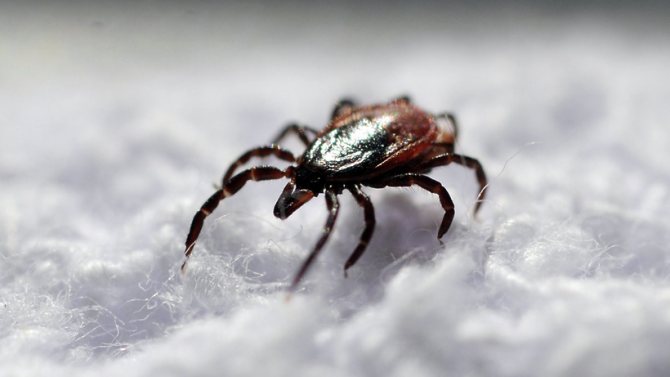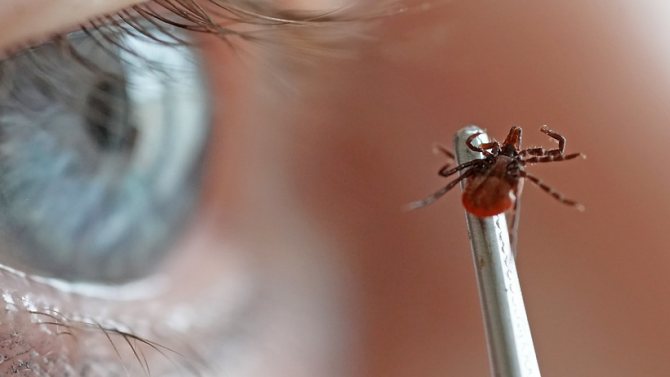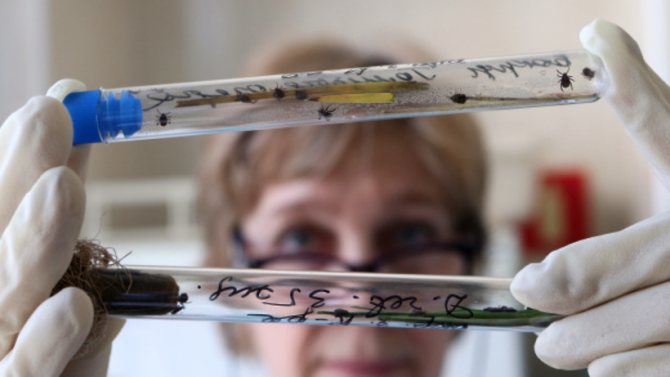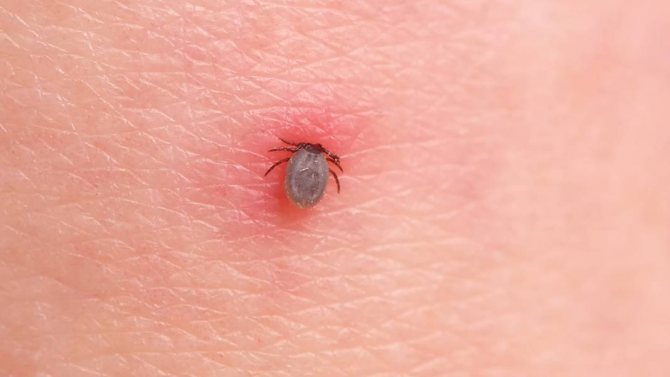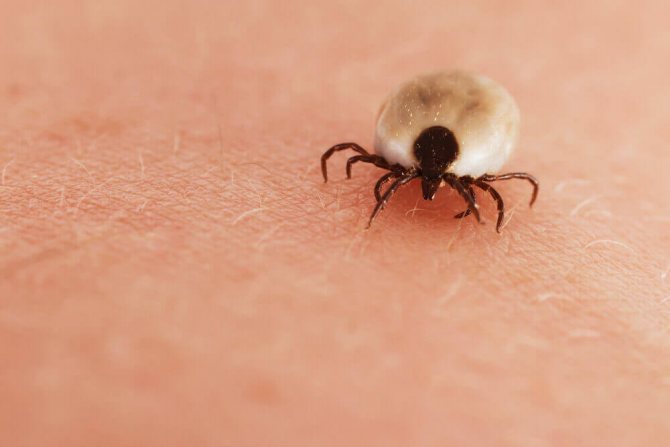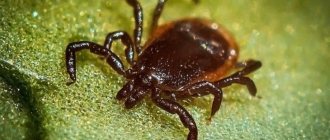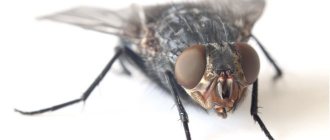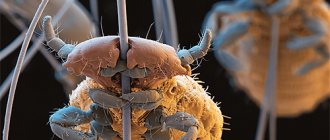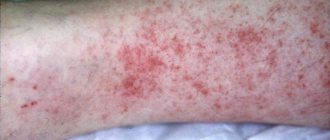The widespread version that a forest tick falls on a person from an oak tree, oddly enough, is erroneous. Ticks hide where you don't expect to see them. On the branches of bushes, in the grass, along the edges of the trodden paths, in the thickets.
This blood-sucking arthropod has a very strong sense of smell and instantly "rushes" at a person or animal as soon as they appear nearby.
Ticks are activated in the period from April to September - until the first frost. The most dangerous period is from the end of April to July. Ticks live in forest and park areas, where there is no direct sunlight and the temperature does not exceed 20 degrees. So be careful when entering places of forest coolness.
How the tick bites and where
The pest looks around for some time, looking for a favorable place for a bite. This process takes approximately half an hour. It digs into places where the skin is thin, blood vessels are located closer to the surface.
- armpits;
- groin;
- stomach;
- small of the back;
- chest;
- behind the ears;
- neck;
- scalp.
On a note!
The tick bite itself is painless. The head penetrates the skin, the abdomen remains outside. The hungry tick is no more than 3 mm in size, so it often goes unnoticed. In the process of feeding, the abdomen increases in size up to 10 mm in diameter and more.
Assistance measures
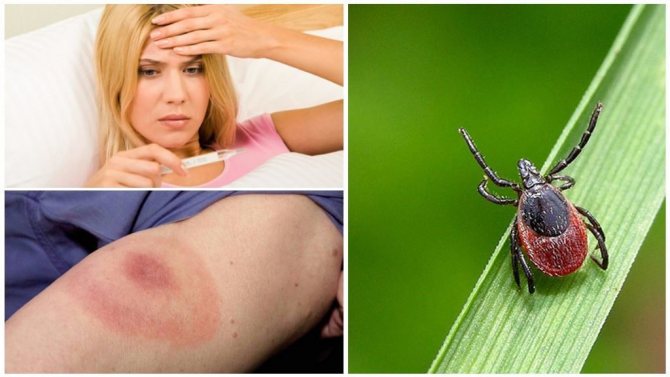
Cases of tick bites without preserving the parasite itself are especially difficult due to the impossibility of examining the insect. Caution should be exercised if there is a suspicion of the presence of a bloodsucker. Frivolity of the victim leads to the development of severe forms of infectious diseases, loss of time for preventive measures.
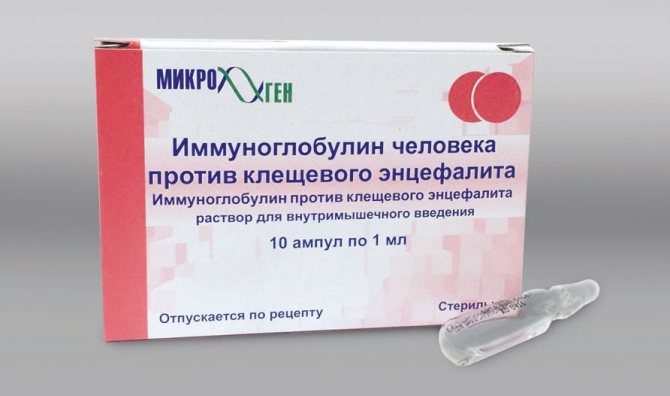

You can protect yourself from the threat of infection by the following actions:
- mark the day of detection of the trail of damage;
- go to the trauma center for wound treatment if necessary;
- make an appointment with an infectious disease doctor.
- Get vaccinated with immunoglobulin prophylactically, within 3 days.
The first symptoms of a deterioration in well-being are a signal to take urgent measures. The introduction of a protective vaccine for infection with encephalitis is effective only with timely treatment. At an early stage of detection of infection, it is possible to cope with the disease without serious consequences, delaying leads to irreversible loss of health.
Symptoms and location of the lesion
Is it possible not to notice a tick bite?
The arachnid bites with powerful jaws, but since they are miniature, the bite itself is not felt. The head quickly penetrates the skin, the parasite slowly sucks blood. Initially, the size of the tick is so small that even with an accidental touch, you may not notice its existence.
After a while, the abdomen increases, becomes convex, oval, sticks out on the surface of the skin, resembles a wart, papilloma. If the parasite has sucked on the back of the head, back, groin, you may not notice it.
The body reacts to a tick bite in different ways. Depends on the sensitivity of the skin, the strength of the immune system, the tendency to allergies. At the site of the bite appears:
- swelling;
- slight redness;
- slight itching;
- in the center, at the site of the parasite's suction, a dark spot with caked blood.


Tick bite
The epidermis recovers on its own within a few days.With such a reaction of the body, you may not notice the bite, not know about its existence. In the presence of allergies, the symptoms are brighter:
- swelling;
- large-scale redness;
- inflammation;
- persistent itching;
- additional rash.
It is impossible not to notice the manifestations of allergies, but you may not know the reasons if the parasite will no longer be at the scene of the "crime".
The earlier the better!
A tick bite is a Russian roulette with health: although the chances of getting sick are not too high, neither you yourself nor the doctors will be able to assess them right away. Before two weeks from the moment of the bite, your tests will not show whether the infection has occurred or not, and when they show it, it will mean that the disease has already developed. At the same time, encephalitis and borreliosis are extremely serious diseases, fraught with both immediate and long-term consequences for the body. The earlier the preventive treatment of borreliosis is started or the emergency immunoprophylaxis of tick-borne encephalitis is carried out, the higher the chances of maintaining your health.
How long does the tick stay on the body
Females and males attack humans. More voracious females, since they need blood to form new offspring. The male can bite and fall off in minutes. A few milliliters of blood are enough to saturate it. Further stay on the body is advisable only if the female remains there. In other situations, the male unnoticeably unhooks, climbs out.
On a note!
The female can also bite and fall off, but this takes longer. To saturate females, up to 20 ml of blood is required. The parasite replenishes these reserves gradually. The time spent on the human body depends on the initial degree of saturation. If the female was not too hungry, she sucks for only a few minutes. In other cases, it lasts up to 3 days.
When the tick falls off on its own, it means that it has completely quenched its thirst, further staying on the body loses its meaning. If the attempt is unsuccessful, the parasite bites a second time, proceeds to the meal.
The earlier the better!
A tick bite is a Russian roulette with health: although the chances of getting sick are not too high, neither you yourself nor the doctors will be able to assess them right away. Before two weeks from the moment of the bite, your tests will not show whether the infection has occurred or not, and when they show it, it will mean that the disease has already developed. At the same time, encephalitis and borreliosis are extremely serious diseases, fraught with both immediate and long-term consequences for the body. The earlier the preventive treatment of borreliosis is started or the emergency immunoprophylaxis of tick-borne encephalitis is carried out, the higher the chances of maintaining your health.
Can a tick bite and crawl away
Such a situation happens if the arachnid adhered to the skin, remained unnoticed until it was completely saturated. The pest gently stretches out its head, disappears. Under natural conditions, the female lays eggs on the soil surface. At home, if this happens, the offspring will not be able to be born. The likelihood that the tick can bite again and leave remains minimal.
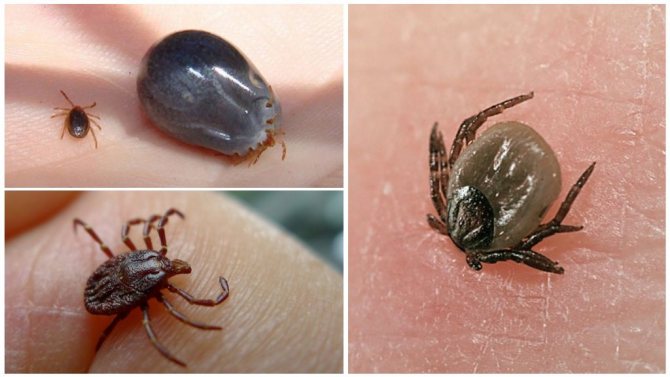

Tick bite
When the tick has sucked and fell off, redness, slight swelling, and slight itching remain at the site of the bite. The skin is restored within a few days. In the presence of an allergic reaction, special treatment is required - the use of local, systemic antihistamines, antiallergic agents. If the tick has been infected, manifestations of the disease appear after 14-60 days.
If the head of the parasite remains in the body
What if the tick burst and the head of the parasite remains in the human body? In this case, you can resort to the following methods:
- Using thread... If a small part of the parasite remains on the surface, then you can use the above loop method.
- Withdrawal with a needle... You will need a regular sewing needle.It is preliminarily disinfected or heated over a fire. Then, with a tip, they gently pry the remaining head of the parasite (according to the principle of removing a splinter) and pull it out of the wound.
Sometimes you can find a recommendation to leave the head in the body. This fragment will eventually decay and will be rejected by the human body. To listen to this recommendation or not - everyone decides for himself. But it should be remembered that the head of the tick also contains particles of infection, which all this time (albeit in small quantities) continue to poison the body.
Consequences of bites from infected ticks
Even if the tick could get out on its own, it remained unnoticed, the virus, when it enters the bloodstream, begins to develop and progress. The first symptoms appear within 1 to 2 months. Depends on the strength of the immune system, the type of disease. The infection is transmitted through saliva, blood.
- Tick-borne encephalitis. The virus enters the human body through the blood. If the infected creature is saturated, it disappears, the infection will not occur. If you accidentally injure him, remove it incorrectly, his blood enters the wound, the virus begins to spread. Affects the spinal cord, brain, nervous system. Leads to disability, paralysis, insanity, death.
- Lyme disease or borreliosis. The infection is transmitted through saliva. It affects the central nervous system, heart, joints. In case of untimely treatment, the presence of complications leads to disability, death.
- Ehrlichiosis. Less common disease. The virus leads to respiratory, renal failure.


Diseases from ticks
Other diseases transmitted through a tick bite are typhoid, anaplasmosis, babesiosis, tularemia, hemorrhagic fever.
Important!
The first signs of the disease resemble the flu. Fever, nausea, vomiting, muscle aches, weakness, headache, fever, etc. appear. The condition returns to normal after 5-7 days, but recovery does not occur. Within a month, the disease again makes itself felt, but with renewed vigor, with other symptoms. Treatment is carried out in a hospital.
What mistakes can be
We have all heard about such a popular method, when the tick is poured with oil, some even use kerosene or other oily liquids. This method is based on the fact that the air is blocked for the insect with the help of oil, so it begins to suffocate, dies and it is not difficult to get it.


If you consider the process itself, then this is really true, but this method is very dangerous. The fact is that when the parasite stops receiving air, it experiences stress, which can go deep into the wound. In addition, when death occurs, he excretes a large amount of food that he has already consumed and saliva, which contains the infection. This means that, using this method, we, on the contrary, expose ourselves to even greater danger.
It is a big mistake not to be serious about the situation. It is necessary to remember the elementary rules for disinfecting instruments and wounds. After removal, the wound is necessarily treated and sealed. You can't brush it. In fact, there is a very high risk of other bacteria and infections entering the wound, which is also dangerous to health.
It is also a mistake not to contact medical institutions. Given the seriousness of the situation and the deadly diseases that are transmitted through the bite of these blood-sucking animals, then all possible actions must be taken to prevent serious consequences.
Prevention means
You can prevent a tick bite by observing the basic rules of behavior:
- Wear tight clothing with cuffs, elastic bands, socks, hats. If the pest does not get to the skin, it falls from the clothes back to the ground, does not bite.
- Use anti-tick products.Aerosols and sprays are used - Gardeks, Taiga, Raptor, Reid, Clean House, etc. The action lasts a maximum of 2 hours, then you need to repeat the processing of clothes.
- Examine the body every 2 hours. This will help remove parasites that have not yet adhered.
- Upon returning home, throw all things into the wash, take a shower or a bath. Examine the body again, especially in places of possible suction of ticks.
The main preventive measure against encephalitis, borreliosis, is vaccination. After extracting the parasite, it is recommended to send the tick to the laboratory for examination. If a virus is detected, drugs are administered to a person to prevent the progression of the disease.
Summing up
Summing up all of the above, we can say with complete confidence that a tick bite carries a huge danger to human health. If there is an opportunity to seek medical help, you cannot refuse it. Try to do your best to avoid dire consequences.
Remember to dress properly when going outdoors. Remember that the parasite attacks a child more often than an adult. Check your clothes regularly. These bloodsuckers move quite slowly, when they get on clothes, they seek access to the body, at this time they are easy to find and take off. Use repellents that are capable of providing reliable protection.
Preventive actions
Remember that it is important for nature to choose the right wardrobe. Clothing should cover the body as much as possible. Tuck your pants into your socks and your sweater into your pants. Be sure to wear hats. Remember that the jacket should have elastic cuffs, and the collar should be tightly attached to the neck. This will give the ticks a minimum chance of making their way to the body.
Avoid the thickets, walk along the paths and relax in the clearings. Check each other's clothes regularly for insects. Don't change clothes in the woods. Use special repellents to help keep out ticks and other insects.
Tick-borne encephalitis treatment
The development of a tick occurs in the following sequence: an egg, after which a larva appears, from which a nymph is formed. Only after this does an adult tick appear. In order to hatch from an egg, the larva must eat well. It is only after she drinks a sufficient amount of blood that she turns into a nymph. Unlike the larva, which has only 6 legs, the nymph has as many as 8 limbs. After some time, the nymph grows into a tick.


It is generally accepted that the larvae feed only on the blood of animals, but there are situations when they attack people. Adults can drink both human and animal blood. The female can begin to lay eggs only after she is well drunk with blood. After the eggs have been laid, the female dies.
It has long been proven that ticks do not fly or jump on humans. In order for the tick to be on the human body, it will be enough to pass very close to it. Ticks are most often found on plots of land and plants. To identify a potential victim, they use their senses, which react to the heat and smell of a person.
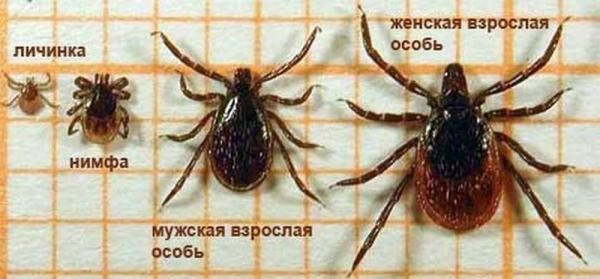

After the tick is determined with a place on the body, it begins to dig into the skin with its claws and proboscis. Most people do not feel pain while the tick bites, as there are special painkillers on its proboscis.

